Types of Premium Quality Honey
Honey is the most fascinating of all the great ingredients out there. A colony can contain tens of thousands of bees, all working in unison to create this delicious sweet product. A product, full of health benefits, that has been nourishing mankind over the many years of its existence.
With time, raw honey and even honey nutrition has garnered a lot of attention for their multiple health advantages. Have you ever noticed the aisles of a supermarket filled with different types of honey? These cover a range of flavours, textures, regions and prices. And with at least 300 different types of honey produced around the world, it becomes difficult to understand, which type of honey is best suited for our health. It’s no wonder some of us don’t know which types to go for when we want some to cook with, mix into drinks, spread on toast and also as nutrition for our body.
Ever wondered why a jar of bee pollen nutrition is expensive as compared to the price of regular honey nutrition? Why does honey differ in colour? How is honey actually made? This all depends on the quality of the honey and how organic it is.
It would be impossible to cover every single honey in just one article, but we’ve shed light on some of the most common and high-quality varieties of honey below. If you’re after truly flavourful honey that’s filled with nutritional health benefits, go beyond the industrially made, over-processed and pasteurised kinds of honey and seek out something special.
Honey is a vital ingredient for our health as it adds a natural sweetness to our nutrition but it’s also just a good spread on toast or drizzled over desserts. See which ones make the list.
Manuka Honey
Manuka honey is a monofloral honey produced from the nectar of the manuka tree that originated in New Zealand. The manuka tree is also indigenous to some parts of coastal Australia, but is today produced globally. Used as a sugar substitute, it has a strong, earthy aroma and flavour. This is the world’s leading honey widely used by people of all ages to bolster their immune system.
Wildflower Honey
If bees have access to a large variety of different flowers around their hive, then the resulting honey is often called wildflower and also referred to as polyfloral. This is because the beekeeper cannot be sure which plants the colony is harvesting. This doesn’t mean the honey is inferior in quality, it simply means that it’s derived from a combination of different nectars, each with its own flavour profiles and benefits. The flavour can vary but overall they are usually boldly floral, pleasantly sweet and ideal for a huge variety of uses.
Acacia Honey
Acacia honey is considered to be light and delicate. It stays in a liquid state for years before crystallising, which makes it ideal to be used as honey nutrition or drizzling or stirring into drinks. The colour can range from pale yellow to almost clear and it has a prominent floral flavour that also goes particularly well with cheese.
Regina Healthcare puts premium honey nutrition at the core of its products. We have compiled a wide range of honey-based products for your health. Do check them out on our website.

